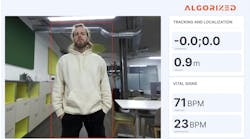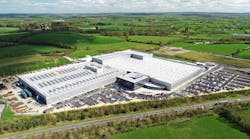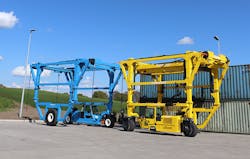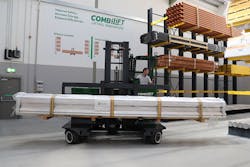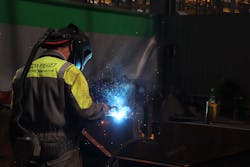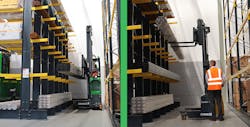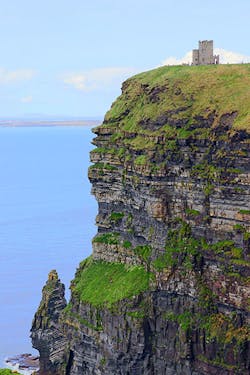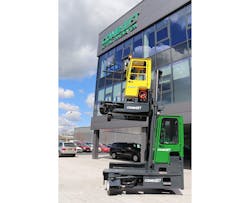This past April, my wife and I landed in Dublin and were immediately faced with the most horrific material handling situation imaginable: Somehow, the baggage handlers at Chicago O’Hare International failed to put my wife’s luggage on the Aer Lingus flight to Ireland.
After more than seven hours in the air, losing five hours to the time zone change, and another one groggily shuffling through customs, finding out most of her amenities and outfits hadn’t joined us didn’t do much to change my wife’s already low opinion of travel and flying. And it certainly wasn’t a good first impression for the Emerald Isle—from which both our families emigrated. So much for the luck of the Irish.
Jet lag and sleep deprivation clouded our thoughts as thoroughly as the gloomy shroud perpetually covering this craggy island.
Then something amazing happened. I spotted a big sign for Combilift, the forklift manufacturer I was set to tour the next week. A chipper young man wearing a button-down shirt with the company logo greeted me as I approached the sign. (I don’t believe he said "Top o’ the morning to ya,’" but I may have to him.)
He was expecting me and seemed very concerned over our suitcase ordeal, offering to have someone deliver the bag to our hotel if it ever arrived. The airport was going to do that, but the gesture was appreciated.
Over the next few days, the company would be receiving distributors, customers, and several other journalists for the $58 million facility’s christening, so worrying about one writer’s wife’s bag shouldn’t even register on their list of concerns. He then set up a taxi to take us to our hotel, also unnecessary and unexpected.
At this point, you are fully within reason to wonder what this has to do with anything. I should just chalk it up to a foreign company trying to make a good impression on a trade journalist, or maybe it was one kind Irish soul who took pity on two cranky, disheveled Yanks.
That’s what I thought, until the next week when I met several American Combilift customers at the welcome reception in downtown Dublin and the plant walkthrough in County Monaghan.
It turns out, more important than any one material handling product Combilift offers, the company’s true innovation is its eagerness to provide the perfect solution for an industrial client’s need. So the company’s reaction to our minor lost bag issue, it seems, was really just muscle memory.
Each American guest at the event went on and on about how Combilift’s versatile equipment transformed their business and had a genuine rapport with their Combilift hosts, from plant manager Mike Nesbitt at metal building manufacturer Schulte Building Systems in Houston (who gushed about how Combilift’s catalog of versatile machines allows them to easily handle pipes for the oil and gas industry), to Wes Oliver, equipment manager at RAI Steel in Athens, Ga.
"It has changed our business model tremendously," Oliver told the room full of press.
In 2011, RAI had a big job with Caterpillar, involving "tons and tons of steel," one of many big machinery customers that also includes Boeing and Lockheed Martin. They had a short time to move three steel beams over the weekend, and a distributor brought in two Combilift Straddle Carriers, massive 20-ton lifters that roll over a shipping container or long load and pull them up within the frame. Because of the stability, they can lift 30 tons.
For Oliver, who was used to overhead cranes, the design was disconcerting. "It was like witchcraft or something," Oliver says. "You press a button and it’s going sideways."
After the two machines completed the job, Oliver became a believer. "I don’t care what they cost; we’re buying them," Oliver recalls saying.
"We know in the future now what to charge ya," quipped Martin McVicar, Combilift co-founder and managing director, getting a burst of laughs.
It’s funny because grifting customers seems like the last thing Combilift would do. A Dublin cabbie? Absolutely. But not these folks.
McVicar attributes the success of Combilift, which now has an annual revenue of $280 million and has doubled production in the last five years, to doing whatever it takes to find value for customers, and making them feel valued. "It’s listening to our customers and designing a product around their needs," McVicar says. "We’d like to keep an open dialogue with our customers and dealers. We have an open line. We’re trying to build a culture."
Putting the Custom in Customer Service
McVicar began as a design engineer in the 1990s for Moffet Engineering, which invented the Moffet Mounty lift truck-mounted forklift. The company was bought out in 1997, so McVicar and former boss Robert Moffet partnered to form Combilift the next year. The company now employs 550 people, making it a critical part of the economy of this region just south of the Northern Ireland border.
The material handling landscape was populated by general-use forklifts with the forks at the front, a design responsible for 85 deaths a year in the U.S., according to OSHA. Nearly half were crushed by tipped-over vehicles. The three-wheeled, all-wheel-drive Combilift maneuvers multi-directionally and offered the world an alternative.
"Rather than a regular forklift handling a long load and airplaning it above other products, machinery, and people, the Combilift can travel in all four directions with the load-bearing platform as close to the ground as possible. And traveling in the direction of the length of the load makes it as safe as possible," explains Paul Short, Combilift’s North American president and a design engineer at the company for 15 years.
An extra "leg" in the front allows for a higher mast as well, so racks can go higher.
Short says this also allows the Combilift—such as the C-Series and CB, the most popular for manufacturing environments—to operate much faster. Combilift says they operated 35 seconds quicker in studies, mainly because the conventional vehicle would have to raise its cargo 14 feet in the air at some points to pass over obstacles.
Combilift’s in-house consultancy service, in conjunction with the forklifts, stackers, and heavy movers, can double customers’ storage capacity by narrowing aisles and allowing equipment to be placed closer together.
The secret the Irish manufacturer was proud to show off lies in the chassis, which acts as the counterweight. Two pieces of 2 to 4-inch thick steel are welded together to create the heavy body, with no additional counterweight needed. They are all customizable for specific users’ needs, with several of the same models on the assembly line all having different chassis.
"A lot of times customers don’t know there’s a better way to do it," Short says.
That’s where Combilift’s true innovation comes in.
"Give us drawings of your existing facility, and free of charge we’re willing to put together animation showing what value our product can bring in terms of space-saving," McVicar says.
A Combilift engineer will survey and measure the site and talk to the client to understand the material flow and manufacturing space, Short says. Combilift returns to the customer with drawings and 3D animation of both the existing layout and recommended concept.
The Irish are known for their craic—a Gaelic word for mirthful, engaging conversation—so it’s likely this process would be more akin to discussing a DIY project with your most spatially aware friends than talking brass tacks and numbers with a salesperson. And removing the Irish gift of gab and charm from the equation, just seeing the actual 3D animation of a Combilift swerving around your slimmed-down warehouse should tell you all you need to know.
For some buildings, a Combilift will make much more sense than others. While warehouse space is always at a premium, for the niche cold storage market, the cost can be three times an ambient building.
In this case, wasted empty space is a chilling proposition. The slim Aisle Master can fit into a 72-inch passage, so a frozen food distributor can fit more racks and more product, or operate in a smaller facility.
The customization extends to the trucks themselves, with options for this application that included heated cabins and windows.
"Squeezing the Air Out"
The benefits of maximizing cold storage should be apparent to anyone who has ever had to pay an electric bill after running an air-conditioner all summer. Optimizing storage has more than an impact on energy bills, though. It creates a butterfly effect that sends ripples of efficiency up and down the production line and throughout the supply chain.
For a typical manufacturer, there’s a finite floor space at one facility. For an auto manufacturer, this room would be better utilized for making cars than storing parts. That’s why the industry seems to prefer the Aisle Master.
"We’re giving them more production space," Short says. "We have customers that have 300,000-ft² storage, and bringing 10 to 14 feet aisles down to 6 feet can give them 25% more storage or more in the same space."
They also benefit when their suppliers can cut down on storage. Aftermarket supplier Aurora Parts & Accessories serves semi-truck manufacturers, such as industry leader Wabash National. Aurora has one 300,000-ft2 distribution center in Lebanon, Ind., and in 2016, wanted to expand to cut lead times from what could be two weeks.
"The customers still expect us to have all the parts," says COO Brad Fulkerson. These parts are often for trailers, and the extruded aluminum pieces can reach up to 53 feet in length.
They had previously used an overhead crane, a bulky mover that takes up a lot of overhead room.
"The leasing of the building is expensive, and we’re a low-margin industrial distribution business," Fulkerson says. "We can’t afford to not run the building at or near capacity."
LEAN Green Manufacturing Machine
"In a matter of two days, they were able to squeeze more air out of the building," says Fulkerson, adding that 30% of the space was saved over the visit. "What we were able to do in a footprint in less than 100,000 square feet was really remarkable."
The new DCs are in Dallas and Atlanta, with two more planned in Los Angeles and Philadelphia.
"Now the buildings are full and operating at capacity," Fulkerson says. "We needed every square foot that we salvaged. It turned out to be an incredibly valuable trip for us."
Aurora currently has about 15 Aisle Masters and a few more heavy-duty C-8000 (kg) models. He also notes that the operators are damaging fewer racks.
"You’re swinging around, not backing directly up, so we didn’t have to over-engineer the width of the racks," Fulkerson says. "There’s plenty of room for our Aisle Master operators to get in and get what they want."
Lead time has been reduced from two weeks to a day for 42% of its customers, with projections of less than 48 hours for 90% soon. (It took more than that for my wife’s suitcase to arrive.)
Now, these benefits are becoming crystal clear.
"[Faster lead times] help all of manufacturing, and speed up the supply chain, and take business from the competition," Fulkerson says.
Fulkerson did not make the recent trip to the new Monaghan site with the other suppliers, so his final thoughts should probably carry more weight:
"We probably would not have been able to do our project had we not come across them and partnered with them designing the facility and equipment at the same time."
Like Ireland’s landscape, the week before my plant visit had plenty of peaks and valleys, experiencing the genuine local charm and beauty of Galway and the disappointing tourist traps and lackluster cuisine of Dublin (save for a solitary bowl of Guinness stew).
All that changed when the caravan of buses from Dublin’s swanky Gresham Hotel arrived at the Monaghan site—a greenfield site spanning 100 acres with 11 under the plant roof.
That roof is covered in solar panels and lined with skylights to reduce energy costs on sunny days, a phenomenon less rare than Irish stereotypes had me believe.
We were greeted warmly, with McVicar shaking hands and chatting with as many guests as he could as they poured through glass doors and into the lobby full of old models and new awards. He proudly mentioned the building’s "L" shape.
The admin offices are in the middle, so design engineers would have less travel time to the production floor and R&D.
And they need all the time they can get working, not walking, as R&D is still as big a factor as it was 20 years ago. The company dedicates 7% of its revenue to developing new ways to solve customer problems and improve quality.
For example, a new paint developed in-house for the vehicles uses 74% fewer VOCs. It’s water-based, making it better for the environment and easier for human painters and sprayers. Most importantly, it’s better for the user if they want to leave it outside.
"If it does get scratched, the rust does not propagate as fast," Short says. It also won’t peel off creating bigger gouges also doesn’t peel and stands up to 850-hour salt spray tests. Water itself is conserved via a rainwater reclamation system for the bathrooms. And rain is definitely not in short supply.
The entire plant, which at launch produced about 9 vehicles a day, seems all about efficiency of operation and space. It’s tightly packed with a lot of bright red and blue boxes, dark green half-finished forklifts, and racks of long black hydraulic hoses.
The assemblers are asked to make several different versions of several different trucks, so keeping everything close and finding them quickly is the difference is paramount.
"The new factory enables us to double production and remain focused on the needs of our customers and dealers," McVicar says.
The customer (and guest) service that day ended with an unforgettable night in a temporary ballroom constructed in the parking lot overlooking rolling green hills filled with dairy cows.
A decent meal (finally), mixed with traditional Irish spirits and traditional Irish music and dance made sure all its visitors had in one night what it took me more than a week to accomplish.
Apparently, they really are good with small spaces.
These forklifts aren’t for every solution, McVicar stresses, and the company has no interest in competing with major forklift manufacturers. According to the company, there are 12 bigger. But what it does, it plans on doing well.
"What’s very much in the Combilift DNA, we focus on the niche markets," McVicar says. "The segments we enter, we are confident we can be the number one player in five to 10 years."







